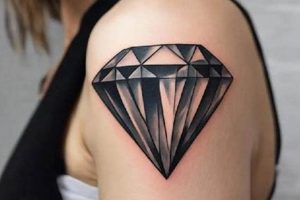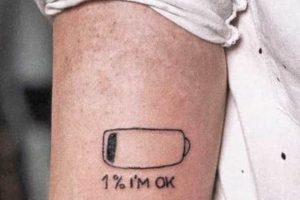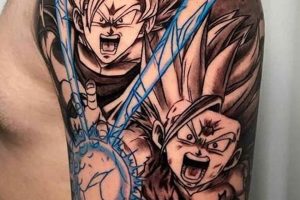A design transferred onto the skin before tattooing, typically using specialized paper and a transfer medium, provides a precise guide for the artist. Examples include intricate mandala patterns, minimalist line drawings, or custom lettering.
These pre-application outlines offer several advantages. They allow for client visualization of the final piece, enable precise placement and sizing, and provide the artist with a clear roadmap for the tattooing process. This practice, rooted in the historical methods of transferring designs, has evolved with technological advancements, resulting in higher fidelity and more intricate possibilities.
Exploration of design options, stencil creation methods, and placement considerations will follow.
1. Design Inspiration
Design inspiration forms the foundation of a successful tattoo stencil. A well-conceived design translates effectively into a precise, workable stencil. The inspiration process draws upon diverse sources, including art history, nature, personal experiences, and cultural symbolism. A client desiring a Japanese-style dragon tattoo, for example, might research traditional Irezumi imagery to inform the design and subsequent stencil creation. The quality of the inspirational source material directly impacts the final stencil and, ultimately, the tattoo itself.
The design inspiration phase requires careful consideration of the desired aesthetic, the tattoo’s meaning, and the technical limitations of the tattooing process. Intricate details, shading techniques, and color palettes must be planned with the stencil creation process in mind. A realistic portrait, for instance, necessitates a highly detailed stencil, capturing subtle variations in tone and texture. This attention to detail during the inspiration phase ensures the artist possesses a clear blueprint for the final piece.
Effective design inspiration minimizes potential challenges during stencil creation and application. A well-defined concept ensures the creation of a stencil that accurately reflects the desired outcome. This careful planning allows for a smoother tattooing process, contributing to a higher quality result. The synergy between design inspiration and stencil creation is paramount in achieving a successful and aesthetically pleasing tattoo.
2. Placement Strategies
Strategic placement is integral to the overall impact of a tattoo. The placement of the stencil dictates the final tattoo’s visibility, how it interacts with the body’s contours, and its aesthetic presentation. A well-placed tattoo complements the client’s physique, enhancing the design’s visual appeal.
- Anatomical Considerations
The human body’s natural curves and musculature influence placement decisions. A design intended for a bicep, for instance, requires a stencil shaped to conform to the muscle’s curvature. Areas with significant movement, like joints, necessitate careful consideration to minimize distortion over time. This ensures the final tattoo maintains its integrity and visual appeal.
- Visibility and Discretion
Placement choices reflect individual preferences regarding visibility. Easily concealed locations, such as the back or thigh, offer discretion. Conversely, highly visible areas like the forearm or hand maximize exposure. Placement strategies must align with the client’s desired level of visibility, reflecting personal expression and societal norms.
- Design Interaction with the Body
Certain designs interact specifically with body contours. A snake tattoo, for example, might be placed to wrap around a limb, utilizing the body’s form to enhance the design’s dynamism. Similarly, a floral design could be strategically positioned to accentuate the collarbone or shoulder blade. This interplay between design and anatomy contributes to the tattoo’s overall artistry.
- Size and Scale
Placement influences the perceived size and scale of a tattoo. A small, intricate design might be lost on a large area like the back, while a large-scale piece could overwhelm a smaller area like the wrist. Careful consideration of the design’s size and the chosen placement area ensures visual harmony and impact. This balance ensures the tattoo is neither dwarfed nor overwhelming.
These placement strategies demonstrate the intricate relationship between stencil design and the final tattoo. Careful consideration of these factors ensures a harmonious integration of the tattoo with the individual’s body, maximizing both aesthetic appeal and personal significance. The strategic placement of the stencil serves as a crucial foundation for a successful and impactful tattoo.
3. Creation Techniques
Stencil creation techniques directly influence the final tattoo’s precision and quality. Selecting the appropriate method depends on the design’s complexity, the artist’s preference, and available resources. Each technique offers distinct advantages and limitations, impacting the stencil’s clarity, durability, and transfer fidelity.
- Hand-Drawing
This traditional method involves drawing the design directly onto stencil paper using specialized markers. Hand-drawing offers artistic control and spontaneity, particularly suitable for simple designs or custom lettering. However, it can be time-consuming and requires significant artistic skill for intricate details. This technique allows for on-the-spot adjustments and creative freedom but may lack the precision of other methods.
- Thermal Transfer Printers
Thermal printers create stencils by transferring a digital image onto thermal stencil paper. This method offers high precision, ideal for complex designs or realistic portraits requiring intricate details and shading. It ensures consistency and accuracy, particularly beneficial for larger or more detailed pieces. While efficient and precise, thermal printers require specialized equipment and software.
- Freehand Tracing
This technique involves tracing a pre-existing design onto stencil paper using a stylus or other tracing implement. It allows for the replication of existing artwork or the adaptation of design elements. While cost-effective and accessible, freehand tracing can be less precise than other methods, especially for intricate designs. This method is suitable for simpler designs or when replicating existing artwork.
- Stencil Machines
Stencil machines, similar to thermal printers, automate the stencil creation process. They utilize specialized software and hardware to create precise stencils from digital images. These machines offer high levels of accuracy and efficiency, particularly for complex designs, but represent a significant investment. Stencil machines streamline workflow but require specialized training and maintenance.
The chosen creation technique significantly impacts the quality and precision of the tattoo stencil. Understanding the nuances of each method allows artists to select the most appropriate technique for a given design, ensuring a successful and accurate transfer to the skin. This careful selection contributes to a more efficient tattooing process and a higher quality final result.
4. Application Methods
Proper application of the tattoo stencil is the crucial final step before the tattooing process begins. A well-applied stencil ensures a clear, precise guide for the artist, directly impacting the final tattoo’s quality and accuracy. The application process involves several key steps, each contributing to the stencil’s adherence and clarity on the skin.
- Skin Preparation
Thorough skin preparation is essential for optimal stencil adherence. The area to be tattooed must be cleansed and shaved to remove any hair or debris that could interfere with the transfer process. A specialized cleaning solution is often used to further sanitize the skin and remove residual oils. Proper skin preparation ensures a smooth, clean surface for optimal stencil application.
- Stencil Placement and Adherence
Precise stencil placement is critical for achieving the desired tattoo design. The stencil is carefully positioned on the prepared skin, ensuring proper alignment and orientation. A transfer medium, typically a specialized gel or liquid, is applied to the back of the stencil to facilitate adhesion. The stencil is then firmly pressed onto the skin, ensuring complete contact and preventing air bubbles or wrinkles. Careful placement and adherence prevent distortions and ensure the design transfers accurately.
- Transfer Medium Selection
Different transfer mediums offer varying levels of tackiness and longevity. The choice of transfer medium depends on the stencil’s complexity, the client’s skin type, and the artist’s preference. Some mediums are designed for intricate details, while others offer extended wear for larger pieces. Selecting the appropriate transfer medium ensures the stencil remains in place throughout the tattooing process, minimizing blurring or smudging.
- Drying and Setting Time
Allowing adequate drying and setting time is crucial after applying the stencil. This allows the transfer medium to fully adhere to the skin, ensuring the stencil remains in place during the tattooing process. Drying times vary depending on the specific transfer medium used and the ambient temperature. Sufficient drying time prevents accidental smudging or removal of the stencil, preserving the design’s integrity.
These application methods demonstrate the critical link between the tattoo stencil and the final artwork. Meticulous application ensures the stencil adheres securely to the skin, providing a precise and reliable guide for the artist. Proper application techniques contribute significantly to the overall quality, accuracy, and longevity of the tattoo, highlighting the importance of this often-overlooked stage in the tattooing process. A well-applied stencil sets the stage for a successful and aesthetically pleasing tattoo, demonstrating the interconnectedness of each step in the process.
Tips for Tattoo Stencils
Optimizing the stencil creation and application process significantly contributes to a successful tattoo. These tips offer practical guidance for achieving optimal results, focusing on clarity, precision, and efficiency throughout the process.
Tip 1: Invest in High-Quality Stencil Paper: Utilizing premium stencil paper specifically designed for tattooing ensures crisp lines and efficient transfer. Inferior paper can lead to blurred lines and poor transfer quality, compromising the final tattoo.
Tip 2: Utilize Sharp Transfer Markers: Dull or dried-out markers create unclear lines and smudging. Sharp, dedicated stencil markers provide clean, precise lines, essential for accurate transfer and a clear guide for the artist.
Tip 3: Practice Proper Skin Preparation: Thoroughly cleaning and shaving the application area is crucial. Residual oils, lotions, or hair can impede stencil adherence and lead to uneven transfer, affecting the tattoo’s clarity.
Tip 4: Experiment with Different Transfer Mediums: Various transfer mediums offer different levels of tackiness and longevity. Experimentation helps determine the optimal medium for specific skin types and stencil complexities, ensuring secure adhesion throughout the tattooing process.
Tip 5: Consider Body Contours During Design: Designs should complement the natural curves and musculature of the body. Ignoring anatomical considerations can result in distorted or poorly placed tattoos, diminishing their aesthetic appeal.
Tip 6: Test Stencil Placement Before Final Application: Use deodorant or a similar non-permanent medium to test stencil placement and ensure proper alignment and sizing. This allows for adjustments before committing to the final transfer, minimizing potential errors and ensuring client satisfaction.
Tip 7: Allow Ample Drying Time: Rushing the stencil drying process can lead to smudging or incomplete transfer. Allowing sufficient drying time ensures the stencil adheres securely, providing a reliable guide for the artist and contributing to a cleaner, more precise tattoo.
Adhering to these tips enhances the stencil process, resulting in cleaner lines, precise transfers, and ultimately, a higher quality tattoo. Careful attention to these details elevates the entire tattooing experience, benefiting both the artist and the client.
These practical insights into stencil creation and application provide a foundation for achieving optimal results. The subsequent conclusion will summarize the importance of these processes in creating successful and aesthetically pleasing tattoos.
Frequently Asked Questions about Tattoo Stencils
This section addresses common queries regarding tattoo stencils, providing clarity on various aspects of the process.
Question 1: How long does a tattoo stencil typically last on the skin?
Stencil longevity varies depending on the transfer medium, skin type, and environmental factors. Generally, a stencil lasts several hours, sufficient for a typical tattoo session. However, excessive sweating or friction can shorten its lifespan.
Question 2: Can any design be made into a tattoo stencil?
While most designs are adaptable, highly intricate designs with extremely fine details might present challenges during stencil creation and transfer. Consulting with a tattoo artist during the design phase ensures feasibility.
Question 3: Is it painful when the tattoo stencil is applied?
Stencil application is generally painless. The process involves pressing the stencil onto the skin, which may cause slight pressure but no significant discomfort. The sensation is often compared to applying a temporary tattoo.
Question 4: Can a stencil be reused for multiple tattoo sessions?
Stencils are typically single-use. Once applied and removed, the stencil loses its integrity and cannot be reliably reused. Attempting to reuse a stencil can result in blurred lines and an inaccurate transfer.
Question 5: What factors affect stencil quality?
Several factors, including the quality of the stencil paper and transfer medium, the sharpness of the drawing instrument, and the artist’s skill, influence stencil quality. Proper storage of stencil materials also contributes to their longevity and effectiveness.
Question 6: How can one ensure the stencil remains in place during a long tattoo session?
Selecting a high-quality transfer medium specifically designed for extended wear and allowing adequate drying time are crucial. Avoiding excessive movement or contact with the stenciled area also helps maintain its integrity throughout the tattooing process.
Understanding these frequently asked questions provides valuable insight into the importance of tattoo stencils in achieving a successful tattoo. A well-created and properly applied stencil is fundamental to a precise, aesthetically pleasing, and long-lasting tattoo.
The following section concludes this exploration of tattoo stencil ideas.
Conclusion
Exploration of tattoo stencil ideas reveals their crucial role in successful tattooing. From design inspiration and placement strategies to creation techniques and application methods, each step significantly impacts the final result. High-quality materials, precise execution, and careful consideration of anatomical contours contribute to a clear, accurate, and durable stencil. Addressing frequently asked questions clarifies common concerns and underscores the importance of proper stencil practices.
Tattoo stencil ideas represent more than mere preliminary steps; they are the foundation upon which a successful tattoo is built. A well-executed stencil empowers artists to translate artistic vision into reality with precision and confidence. Continued exploration of innovative techniques and materials will further refine this essential process, ensuring the art of tattooing continues to evolve and flourish.







